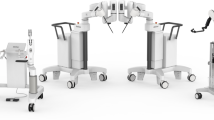Abstract
Background
The aim of this study was to demonstrate a proof-of-concept approach to rectopexy that would provide the durability of the transabdominal procedure through use of sacral rectopexy with the decreased morbidity of a perineal procedure. This was done by utilizing a transvaginal approach and developing the rectovaginal space to accommodate sacral rectopexy placement using the Flex® Colorectal Drive Robotic System by Medrobotics (Medrobotics Corp., Raynham, MA, USA).
Methods
A fresh female cadaver was acquired and placed in the high lithotomy position. The rectovaginal space was developed to accommodate the trocar of the Flex robot using blunt and sharp dissection between the posterior vaginal wall and anterior rectum. A piece of mesh was introduced into the space and using an endoscopic tacker, which was secured to the sacral promontory. The mesh was secured to the anterior rectal wall using interrupted vicryl sutures. The purse string suture was removed and the rectovaginal orifice was closed using a running vicryl suture. At the completion of the procedure, a low midline laparotomy was conducted to verify anchoring of the mesh appropriately at the sacral promontory.
Results
This proof-of-concept protocol is the first description of the Flex® Colorectal Drive being used successfully to perform a transvaginal rectopexy for rectal prolapse in a cadaver. This is also the first description of the Flex® Colorectal Drive robot being used transvaginally.
Conclusions
This proof-of-concept approach demonstrates that transvaginal rectopexy using the Flex® Colorectal Drive is a potential surgical option to address rectal prolapse that could provide patients the durability of a transabdominal approach with the decreased morbidity of a perineal approach. While early results are promising, additional cadaveric studies are required before this procedure can be attempted in vivo.


Similar content being viewed by others
References
Madiba TE, Baig MK, Wexner SD (2005) Surgical management of rectal prolapse. Arch Surg 140:63–73
Varma M, Rafferty J, Buie WD (2011) Practice parameters for the management of rectal prolapse. Dis Colon Rectum 54:1339
D’Hoore A, Penninckx F (2006) Laparoscopic ventral recto(coo)pexy for rectal prolapse: surgical technique and outcome for 109 patients. Surg Endosc 20(12):1919
Remacle M, Prasad VM, Lawson G, Plisson L, Bachy V, Van der Vorst S (2015) Transoral robotic surgery (TORS) with the Medrobotics Flex™ System: first surgical application on humans. Eur Arch Oto-Rhino-Laryngol 272(6):1451–1455
Deepraj SB (2014) Laparoscopic rectopexy for complete rectal prolapse: mesh, no mesh or a ventral mesh? J Minim Access Surg 10(1):1–3
Yang SJ, Yoon SG, Lim KY, Lee JK (2017) Laparoscopic vaginal suspension and rectopexy for rectal prolapse. Ann Coloproctol 33(2):64–69
Gurland B (2014) Ventral mesh rectopexy: is this the new standard for surgical treatment of pelvic organ prolapse? Dis Colon Rectum 57(12):1446–1447
Consten EC, van Iersel JJ, Verheijen PM, Broeders IA, Wolthuis AM, D’Hoore A (2015) Long-term outcome after laparoscopic ventral mesh rectopexy: an observational study of 919 consecutive patients. Ann Surg 262(5):742–748
Samaranayake CB, Luo C, Plank AW, Merrie AE, Plank LD, Bissett IP (2010) Systemic review on ventral rectopexy for rectal prolapse and intussusception. Colorectal Dis 12(6):504–512
Faucheron JL, Trilling B, Girard E, Sage PY, Barbois S, Reche F (2015) Anterior rectopexy for full-thickness rectal prolapse: technical and functional results. World J Gastroenterol 21(16):5049–5055
Gurland B, Garrett KA, Firoozi F, Goldman HB (2010) Transvaginal sacrospinous rectopexy: initial clinical experience. Tech Coloproctol 14(2):169–173
Funding
This study was performed without grant support or support from other financial relationships.
Author information
Authors and Affiliations
Corresponding author
Ethics declarations
Conflict of interest
Author V. Obias is a consultant for Intuitive Surgical and Medrobotics. Authors J. Paull, S. Parascandola, A. Graham, S. Hota, N. Pudalov, S Stein, B. Umapathi MD, and A. Abdullah declare that they have no conflict of interest.
Ethical approval
All procedures performed in studies involving human participants were in accordance with the ethical standards of the institutional research committee [The George Washington University Committee on Human Research, Institutional Review Board (IRB), FWA00005945] and with the 1964 Helsinki declaration and its later amendments or comparable ethical standards. This article does not contain any studies with animals performed by any of the authors.
Informed consent
Informed consent was obtained from all individual participants included in the study.
Additional information
Publisher's Note
Springer Nature remains neutral with regard to jurisdictional claims in published maps and institutional affiliations.
Rights and permissions
About this article
Cite this article
Paull, J.O., Graham, A., Parascandola, S. et al. Transvaginal rectopexy using the Flex® Colorectal Drive Robotic System: a proof-of-concept approach to rectal prolapse. Tech Coloproctol 24, 471–474 (2020). https://doi.org/10.1007/s10151-020-02180-2
Received:
Accepted:
Published:
Issue Date:
DOI: https://doi.org/10.1007/s10151-020-02180-2




